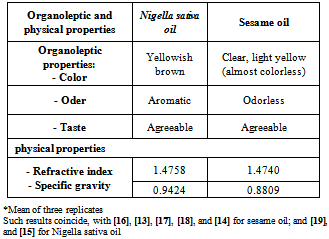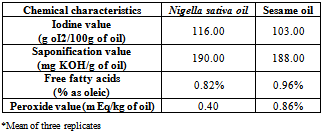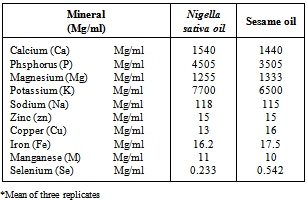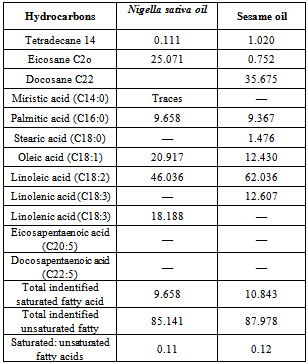-
Paper Information
- Paper Submission
-
Journal Information
- About This Journal
- Editorial Board
- Current Issue
- Archive
- Author Guidelines
- Contact Us
Food and Public Health
p-ISSN: 2162-9412 e-ISSN: 2162-8440
2013; 3(6): 309-314
doi:10.5923/j.fph.20130306.07
Physicochemical Characteristics, Nutrient Content and Fatty Acid Composition of Nigella sativa Oil and Sesame Oil
M. Kamal E. Youssef1, Nareman S. Eshak2, Randa S. Hana3
1Food Science & Technology, Food Science & Technology, University, Assiut, A.R. Egypt
2Home Economic Department, Department, Faculty of Specific Education Assiut, Assiut University, Assiut, A.R. Egypt
3Biochemistry Department, Faculty of Medicine, Assiut University, Assiut, A.R. Egypt
Correspondence to: Nareman S. Eshak, Home Economic Department, Department, Faculty of Specific Education Assiut, Assiut University, Assiut, A.R. Egypt.
| Email: |  |
Copyright © 2012 Scientific & Academic Publishing. All Rights Reserved.
The core objective of this research was to determine the physicochemical characteristics, mineral composition, vitamin composition and fatty acid composition of Nigella sativa oil (NSO) than that of (SO). The data indicated that there was a marked variation in iodine value, saponification value, free fatty acids, and peroxide value between NSO and SO. The data revealed that NSO recorded higher values of ascorbic acid and vitamin E than that of SO. Besides, NSO had higher levels of Ca, P, K, Na and M than that of SO. While SO had higher levels of Mg,Cu, and Se. Characteristics of NSO and SO revealed higher degree of unsaturation as determined by gas liquid chromatography (GLC) reported herein. The major unsaturated fatty acids were linoleic acid (46.036% in NSO, and 12.607% in SO), followed by oleic acid (20.917% in NSO and 12.430% in SO). The main saturated fatty acid was palmitic acid (9.658% in NSO, and 9.367% in SO) are considered as two newer sources of good edible oils, thanks to their important role in human nutrition health.
Keywords: Physicochemical Characteristics, Minerals, Fatty Acids, Vitamins, NigellaSativa Oil, Sesame Oil and Sensory Characteristics
Cite this paper: M. Kamal E. Youssef, Nareman S. Eshak, Randa S. Hana, Physicochemical Characteristics, Nutrient Content and Fatty Acid Composition of Nigella sativa Oil and Sesame Oil, Food and Public Health, Vol. 3 No. 6, 2013, pp. 309-314. doi: 10.5923/j.fph.20130306.07.
Article Outline
1. Introduction
- Black cumin (Nigella sativa L.) belongs to Ranunculaceae family and is native to some parts of the Mediterranean region .It grows in the Mediteranean countries to a maximum height of about 60 cm and is cultivated in Turkey[1],[2],[3]. Black seed oil is used as edible oil[4]. It is important source of oil being of nutritional ,industrial and pharmaceutical importance .As non-conventional oil, Nigella sativa oil is under consideration because, it has unique chemical properties and may augment the supply of the functional edible oils[2]. Black seed oil is popularly used in certain cases of chronic cough, as diuretic or carminative agent and in bronchial asthma[3]. Little information is available concerning the exact composition of Niglla sativa seed oil. There exist limited studies on the Nigella sativa oil, its properties and the contents of fatty acids and tocopherols[3].Black seed oil is reported to be beneficial in the control or management of African sleeping sikness due to its content of over a hundred components such as aromatic oils, trace elements, and vitamins. It is a phytotherapeutic known to reduce the risk to illness and disease by strengthening immune system and protecting the body. Recent reports however suggest that thymoquinone present in the oil might be the active component[5].Nigella sativa oil is considered as one among newer sources of edible oils, thanks to its important role in human nutrition and health[5]. Sesame (Sesame indicum L.) is believed to be one of the most ancient crops cultivated by humans. It was first recorded as a crop in Babylon and Assyria over 4000 years ago. The seeds of the crop are used both as condiment and oil source. Babylonians used sesame oil for cooking, medical, and cosmetic purposes. Sesame seed has higher oil content (around 50%) than most of the known oil- seed although its production is far less than the major oilseeds such as soybean or rapseed due to laborintensive harvesting of the seeds. Sesame oil is generally regarded as a high- priced and high- quality oil. It is one of the most stable edible oil despite its high degree of unsaturation. The presence of lignan type of natural antioxidants accounts for both the superior stability of sesame oil and the beneficial physiological effects of sesame[6].Despite sesame oil’s high proportion of polyunsaturated (omega-6) fatty acids, it is least prone, among cooking oils with high smoke points, to turn rancid when kept in the open[19]. This is due to the natural antioxidants present in the oil[7].Sesame oil is a source of vitamin E.Vitamin E is antioxidant and has been correlated with lowering of cholesterol levels. Sesame oil also contains magnesium, copper, calcium, iron, zinc, and vitamin B6. Copper provides relief to rheumatoid arthritis. Magnesium supports vascular and respiratory health. Calcium helps prevent colon cancer, osteoporosis and migraine[6]. The present investigation was carried out to assess the physic- chemical characteristics, nutrients content and fatty acid composition of black seed (Nigella sativa) oil and sesame oil.
2. Materials and Methods
2.1. Materials
- 2Kg of natural Nigella Sativa oil (black seed) were produced from Chema Lab Company, Assiut Governorate in November, 2012.2Kg of natural sesame oil (Sesamum indicum L.) were obtained from Chema Lab Company, Assiut Governorate in November, 2012.
2.2. Methods
2.2.1. Determination of Physical and Chemical Properties: Refractive Index
- At 25℃, specific gravity, acid value, peroxide value, iodine value and saponification value were determined as outlined in[8].
2.2.2. Determination of Minerals Contents
- The samples were wet acid-digested using a nitric acid and perchloric acid mixture (HNO3; HCSO4; 2:1v/v). The amounts of iron, zinc, copper and manganese in the digested sample were determined using a GBC Atomic Absorbation Spectrophotometer 906 A, as described in[9]. Sodium and potassium were determined by a flame photometer 410, calcium and magnesium were determined by titration with version 0.0156 N. Phosphorus, and selenium were determined according to the methods described by[9].
2.2.3. Determination of Vitamin Content
- Vitamin C was determined according to[10]. Vitamin E was determined according to the method described by[11].
2.2.4. Fatty Acids Composition
2.2.4.1. Preparation of Methyl Ester of Fatty Acids
- The methyl esters of fatty acids were prepared from aliquots total lipids using 5 ml 3% H2SO4 in absolute methanol and 2 ml benzene as mentioned in[12]. The contents were heated for methanolysis at 90℃ for 90 minutes. After cooling, phase separation was performed by addition of 2 drops of distilled water and methyl esters were extracted with 3 aliquots of 2 ml hexane each. The organic phase was removed, and filtered through anydrous sodium sulfate.
2.2.4.2. Gas Liquid Chromategraphic of Methyl Esters of Fatty Acids
- Fatty acid methyl esters were injected into (HP 6890 series GC) apparatus provided with a DB-23 column (60m × 0.32mm × 25 µm). Carrier gas was N2 with flow rate 2.2 ml/min, splitting ratio of 1:50. The injector temperature was 250℃ and that of Flame Ionization Detector was 300℃. The temperature setting was as follows: 150℃ TO 225℃ at 5℃ /min, and then held at 225℃for 20 min. Peaks were identified by comparing the retention times obtained with stander methyl esters.
3. Results and Discussion
3.1. Organoleptic and Physical Properties
- The organoleptic and physical properties of Nigella sativa oil and sesame oil established its capability of application in either nutrition or in food and pharmaceutical industries. Data of organoleptic and physical properties of Nigella sativa oil and sesame oil are outlined in Table (1). The color, odor, and taste of the two studied oils were: yellowish brown, aromatic, and agreeable; clear light yellow, odorless, and agreeable for Nigella sativa oil, and sesame oil; respectively. The results indicate that there is a slight variation in refractive index between the two studied oils. However, the specific gravity of Nigella sativa oil was markedly higher than that of sesame oil. The results are in good agreement with[13],[14] for sesame oil; and [15] for Nigella sativa oil.
|
3.2. Chemical Characteristics
- The results of the chemical characteristics of Nigella sativa oil and sesame oil are given in Table 2. The data indicate that there is a marked variation in iodine value, saponification value, free fatty acids, and peroxide value between Nigella sativa oil and sesame oil. High values of refractive and iodine values might be due to a high concentration of unsaturated fatty acids in Nigella sativa oil. Saponification is useful in assessing the chain lengths of fatty acids in the oil, since it is inversely comparatively to the molecular weight of the oil.On the other hand, free fatty acids and peroxide value were higher in sesame oil than that of the corresponding values in Nigella sativa oil. The acid values of an oil may be used as a measure of quality. However, the acid value of the oil must not be too high, as this denotes an excessively high content of free fatty acids, which causes the oil to turn sour. Discoloration may also occur. The free fatty acids of Nigella sativa oil and sesame oil as show in Table 2 are 0, 82%, and 0.96% respectively, being in the allowable limit.
|
3.3. Vitamin Content
- The data of ascorbic acid and vitamin E contents of Nigella sativa oil and sesame oil are given in Table 3 and Fig.1 & 2. Tocopherols are natural antioxidants with biological activity. Especially, the antioxidant effect is higher due to high α- tocopherol content. The data revealed that Nigella sativa oil recorded higher values of ascorbic acid and vitamin E than that of sesame oil (0.770 mg/100ml, 0.623 mg/100ml); and (0.612 mg/100ml, 0.597mg/100ml); respectively. Such data are in good agreement with[3] for Nigella sativa oil, and[7],[20], and[21] for sesame oil. Sesame oil is a source of Vitamin E. Vitamin E is antioxidant and had been correlated with lowering cholesterol levels[20].
|
3.4. Mineral Content
- The mineral content of Nigella sativa oil and sesame oil given in Table 4. The data revealed that Nigella sativa oil had higher levels of Ca, P, K, Na, and M than that of sesame oil. While sesame oil had higher levels of Mg, Cu and Se. Such data are in general agreement with[22], and[23] for Nigella sativa oil; and[7] for sesame oil.
|
|
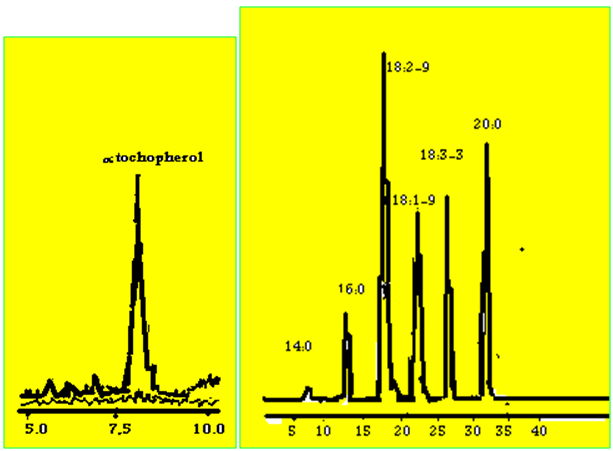 | Figure 1. Separation of fatty acids and vitamin E in Nigela sativa oil |
 | Figure 2. Separation of fatty acids and vitamin E in Sesame oil |
3.5. Fatty Acid Composition
- The data presented in Table 5 and Fig. 1&2 illustrated the fatty acid composition of Nigella sativa oil and sesame oil. The tabulated data showed that the predominant unsaturated fatty acids in both studied oils were lenoleic acid (C18:2) followed by oleic acid (C18:1). While, the predominant saturated fatty acid was palmitic acid in both studied oils. The total unsaturated fatty acids were 85.141% and 87.978% in Nigella sativa oil and sesame oil respectively.The data are in good agreement with [24],[25],[26],[3], [27],[28], and[5] for Nigella sativa oil; and[7] and[21] for sesame oil. It is note- worthy to state that Nigella sativa oil is rich in unsaturated fatty acids, mainly linoleic acid (46.036%), and oleic acid (20.917%). While saturated fatty acid palmitic amounts to 9.658%. Nigella sativa oil is considered as one among newer sources of edible oils, thanks to its important role in human nutrition and health.On the other hand, despite sesame oil’s high proportion of unsaturated fatty acids, it is least prone, among cooking oils with high smoke points, to turn rancid when kept in the open, This is due to the natural antioxidants present in the oil[7]. Light sesame oil has a high smoke point and is suitable for deep frying. Therefore, sesame oil belongs to the oleic- linoleic acid group. It has less than 20% saturated fatty acids[21]. Due to the antioxidant properties of sesame oil which provide high levels of antioxidants and lignans, it is stable oil, and when mixed with other oils, actually increases the stability of the blend[29], and[30].In conclusion, on the basis of the above- mentioned data, both Nigella sativa oil and sesame oil are considered as two among newer sources of good edible oils, on account of their important roles in human nutrition an health.
 Abstract
Abstract Reference
Reference Full-Text PDF
Full-Text PDF Full-text HTML
Full-text HTML